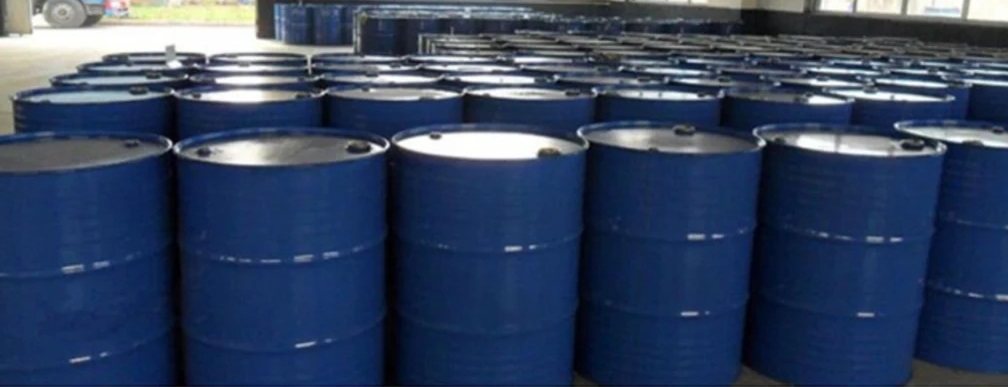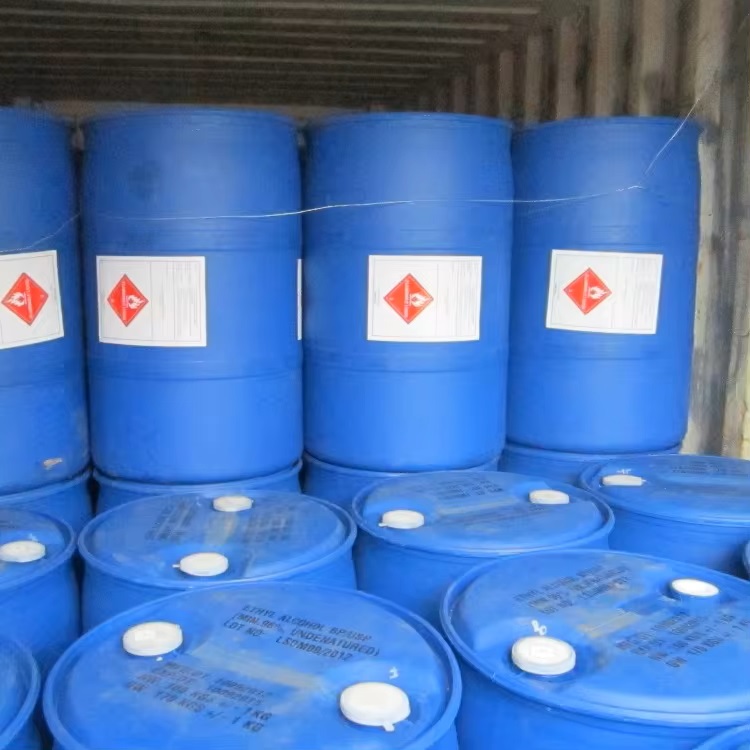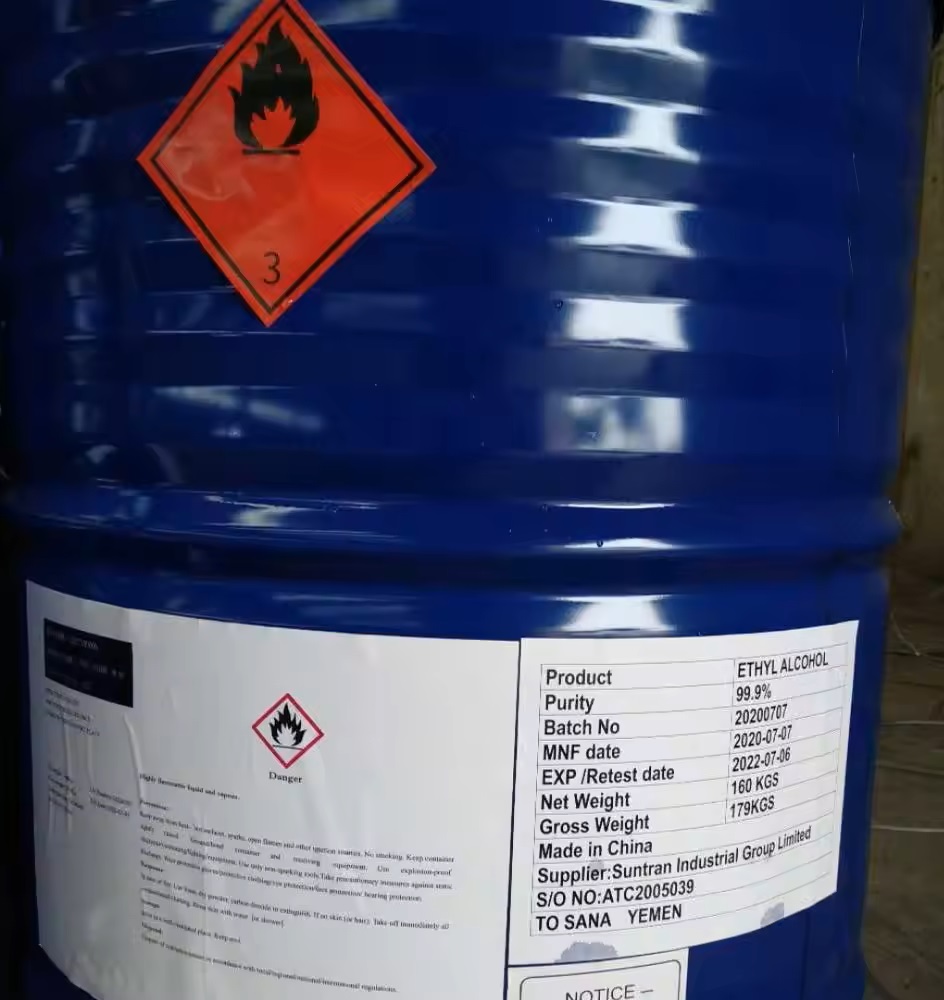We unleash your business potential by maximize the business innovation.
Send EmailEthyl Alcohol, Ethanol, Denatured Ethanol, Grain Alcohol, Vegetable Alcohol, Fermentation Alcohol, Absolute Ethanol, Methylcarbinol, 64-17-5
🧪 Ethanol: Chemical Profile
| Property | Value |
|---|---|
| Chemical Name | Ethanol / Ethyl Alcohol |
| CAS Number | 64-17-5 |
| Molecular Formula | CH₃CH₂OH |
| Molecular Weight | 46.07 g/mol |
| IUPAC Name | Ethanol |
| Synonyms | EtOH, Ethyl Hydroxide, Ethyl Hydrate, Grain Alcohol, Fermentation Alcohol |
🌡️ Physical & Chemical Properties
| Property | Value |
|---|---|
| Appearance | Colorless, transparent liquid |
| Odor | Mild, characteristic |
| Boiling Point | 78.37 °C |
| Melting Point | −114.1 °C |
| Density (at 20 °C) | 0.789 g/cm³ |
| Flash Point | ~13–14 °C |
| Autoignition Temperature | ~363 °C |
| Solubility | Fully miscible with water |
| pKa | ~15.9 |
| Vapor Pressure (at 20 °C) | ~5.95 kPa |
| Flammability | Highly flammable |
🔬 Thermodynamic Properties (Liquid Phase at 25 °C)
| Property | Value |
|---|---|
| Specific Heat Capacity (Cp) | 2.57 kJ/kg·K |
| Heat of Vaporization | 919 kJ/kg |
| Heat of Combustion | ~29,000 kJ/kg |
| Surface Tension | ~22.3 mN/m |
| Thermal Conductivity | ~0.171 W/m·K |
| Sound Velocity | ~1139 m/s |
🧴 Applications of Ethanol
| Sector | Use |
|---|---|
| Medical | Antiseptic, disinfectant, solvent in pharmaceuticals |
| Cosmetic | Perfumes, lotions, hair sprays, toners |
| Food & Beverage | Alcoholic drinks (beer, wine, spirits), flavor carrier |
| Industrial | Solvent, fuel additive, cleaning agent |
| Automotive | Bioethanol fuel, octane booster |
| Laboratory | Preservative, sterilization, reagent |
| Agriculture | Carrier for pesticides and herbicides |
| Electronics | Circuit board cleaner, degreaser |
🔄 Comparison with Other Alcohols
| Property | Ethanol (C₂H₅OH) | Methanol (CH₃OH) | Isopropanol (C₃H₇OH) |
|---|---|---|---|
| CAS Number | 64-17-5 | 67-56-1 | 67-63-0 |
| Boiling Point (°C) | 78.37 | 64.7 | 82.6 |
| Toxicity | Low (drinkable) | High (toxic) | Moderate (not drinkable) |
| Common Use | Beverage, medical | Industrial solvent | Disinfectant, cleaner |
| Odor | Mild | Sharp | Sharp, antiseptic |
| Solubility in Water | Complete | Complete | Complete |
🧠 Safety Notes
-
Ethanol is safe for consumption in regulated concentrations (e.g., alcoholic beverages).
-
Denatured ethanol contains additives to make it undrinkable and is used industrially.
-
Highly flammable: store in cool, ventilated areas away from ignition sources.
Molecular Formula (Ethyl Alcohol): CH3CH2OH
Molecular Weight: 46.069 g/mol
Chemical Name: Ethanol, Ethyl Alcohol
CAS Number: 64-17-5
It can be shown as a clear, colorless liquid that is rapidly absorbed from the gastrointestinal tract in the human body and spreads rapidly throughout the body.
Ethanol is commonly used, sometimes as Ethyl alcohol. The form used in the production of drinkable alcohol is called grain alcohol.
It has bactericidal properties. Therefore, it is the most important chemical in the production of disinfectants.
Ethanol has complex effects. Therefore, it has the ability to affect more than one system in the brain. Its most important feature is that it acts as an agonist.
Other Names Are As Follows;
Ethanol
Ethanol
Ethyl Alcohol
Methylcarbinol
Methylcarbinol
64-17-5
Ethyl Hydroxide
Ethyl Hydrate
EtOH
Absolute Ethanol
Denaturated Alcohol
Denaturated Ethanol
Grain Alcohol
Vegetable Alcohol
1-Hydroxyethane
Fermentation Alcohol
Physical and Chemical Properties:
It is a clear colorless liquid with a characteristically pleasant odor and burning taste.
It is a very flammable chemical substance. Therefore, it is very dangerous. Necessary packaging and safety precautions should be taken during transportation.
The most important feature that makes Ethyl Alcohol indispensable in the industry is that it is used to dissolve other substances. It has a great solvent effect.
It is considered a volatile chemical substance.
Its melting point is -114 °C.
Its boiling point is 78.5 °C.
Its density is 0.8 g/cm3.
The flash point is between 9-11 ° C. This temperature value is very low for a chemical substance to do.
Its vapor is heavier than air. Since its vapor is heavier than air, it settles on the ground.
It can be mixed with many organic solvents.
Where are its uses?
Ethyl Alcohol (Ethanol) is used as a solvent and preservative in pharmaceutical preparations.
It is the main component in the production of alcoholic beverages.
It is a chemical compound used as an organic solvent in the manufacture of paint remover products.
Ethanol is generally used as a solvent for substances that people come into contact with and are produced for human consumption, including fragrances, perfumes, sweeteners, colorants and drugs.
It is used in the production of adhesives and sealants in the chemical industry.
It allows production to start by reacting with oil in the biodiesel production process.
It is used as a solvent in cosmetic products produced for skin rejuvenation.
It is used in the manufacture of non-pesticide agricultural chemicals.
It can be used in the manufacture of functional fluids used in open and closed systems.
It is used in the manufacture of some intermediate products in the industry.
As an indispensable chemical of laboratories, it is unlikely that ethyl alcohol will not be used in a laboratory experiment.
In the health sector, Ethanol is used to provide sterilization when performing procedures on patients in health service providers. After the production of ethyl alcohol used in hospitals is provided, it is offered for use in 1 lt packages. Ethyl alcohol used in the health sector must have purity levels of 96% and above 99%. Chemicals with this purity undergo special processes.
It is among the main raw materials used in ink manufacturing. It is used in the manufacture of pigments.
Ethanol is used as a special processing auxiliary chemical in petroleum production.
Its solvent properties are used in the manufacture of surface active substances.
It is used in the manufacture of vinegar, mustard and alcoholic beverages.
Ethyl is used as a viscosity adjuster in some reactions.
It is used in the manufacture of automotive maintenance products.
It is used in the manufacture of antifreeze and de-icing products.
It is used in the manufacture of industrial cleaning and maintenance products.
It is the best solvent in the food sector.
Ethyl is used as the main solvent of essence in perfume manufacturing. It is dissolved by adding essence to alcohol.
It is used in the manufacture of antibacterial hand disinfectant.
Antibacterial gel is manufactured by thickening with Carbomer and springing with glycerin. Carbomer application is the most important raw material in this field.
Essence manufacturers use it as a solvent. The amount of essence is increased by mixing this compound with Di Propylene Glycol.
It is used to prepare the propolis solution used in the beekeeping sector.
It is used together with Mono Propylene Glycol in the medical field and acts as a solvent in hair growth formulas.
Isopropyl Alcohol or Ethyl Alcohol is used in the cleaning of razors and similar tools in beauty centers and hairdressers.
It is used as a solvent in the production of local anesthetic cream for external use.
🍷 Types of Ethanol Used in Alcoholic Beverages
Only food-grade ethanol is suitable for human consumption. This type is highly purified and free from toxic additives.
| Type of Ethanol | Suitability for Drinking | Notes |
|---|---|---|
| Food-grade Ethanol | ✅ Yes | Used in beer, wine, spirits; derived from fermentation of sugars or grains |
| Grain Alcohol | ✅ Yes | Made from corn, wheat, or rye; common in vodka and whiskey production |
| Vegetable Alcohol | ✅ Yes | Derived from fruits or sugarcane; used in wine and liqueurs |
| Absolute Ethanol (>99%) | ⚠️ Only when diluted | Too strong in pure form; must be diluted before use |
| Denatured Ethanol | ❌ No | Contains additives to make it undrinkable; used in cleaning and cosmetics |
| Industrial Ethanol | ❌ No | Not purified for consumption; may contain toxic impurities |
| Methanol (Methyl Alcohol) | ❌ Extremely toxic | Causes blindness, organ failure, and death if ingested |
🧪 Why Is Ethanol Used in Alcoholic Drinks?
-
Least toxic alcohol for human metabolism
-
Naturally produced via fermentation of sugars by yeast
-
Psychoactive effects: Ethanol acts as a central nervous system depressant, causing relaxation and euphoria
-
Safe in moderate doses: Unlike methanol or isopropanol, ethanol’s byproducts (acetaldehyde → acetic acid) are less harmful
⚠️ Is Ethanol Toxic?
Yes—but toxicity depends on the dose.
-
In small amounts (e.g., a glass of wine), ethanol is generally safe
-
In large amounts, it becomes toxic and can lead to ethanol poisoning
-
Chronic use damages the liver, brain, and heart, and increases cancer risk
🚨 Symptoms of Ethanol Poisoning
| Symptom | Description |
|---|---|
| Confusion | Mental fog, inability to think clearly |
| Slurred Speech | Difficulty speaking coherently |
| Vomiting | Body’s response to excess toxins |
| Slow or Irregular Breathing | Fewer than 8 breaths per minute or gaps between breaths |
| Hypothermia | Drop in body temperature |
| Seizures | Uncontrolled muscle activity |
| Unconsciousness | Loss of awareness; coma in severe cases |
| Pale or Blue Skin | Sign of oxygen deprivation |
Immediate medical attention is required if these symptoms appear4.
🧠 Why Do People Get Alcohol Poisoning?
-
Binge drinking: Consuming large amounts of alcohol in a short time overwhelms the liver’s ability to metabolize ethanol
-
Metabolic overload: Excess ethanol builds up in the bloodstream, affecting vital functions like breathing and heart rate
-
Delayed response: Alcohol continues to absorb even after drinking stops, worsening symptoms over time
-
Drug interactions: Combining alcohol with sedatives or opioids increases toxicity and risk of overdose


